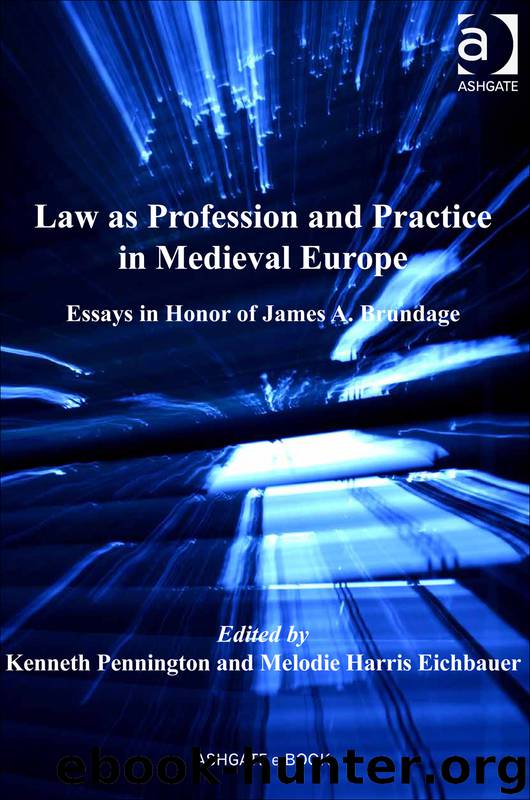Law As Profession and Practice in Medieval Europe by Brundage James A. Eichbauer Melodie Harris. Pennington Kenneth. & Melodie Harris Eichbauer

Author:Brundage, James A.,Eichbauer, Melodie Harris.,Pennington, Kenneth. & Melodie Harris Eichbauer
Language: eng
Format: epub
Publisher: Taylor & Francis (CAM)
Published: 2011-02-28T16:00:00+00:00
Chapter 12
“Deus est procurator fatuorum”: Cloistered Nuns and Equitable Decision-Making in the Court of Chancery
Elizabeth Makowski
In 1468, a subpoena was sued in the Chancery for the breach of a parol [verbal] promise. The defendant argued that the plaintiff’s only remedy lay in the Church courts. The Chancellor [the Bishop of Bath and Wells, Robert Stillington] was short with him. ‘You say that for breach of faith he must sue by the Canon Law; but in this case, because he is damaged by the non-performance of the promise, he shall have a remedy here.’ The defendant persisted that, had the plaintiff taken the trouble to obtain the defendant’s promise under seal, he could have sued in Covenant [by that writ in a common law court], and that it was ‘his folly not to have a deed.’ But the Chancellor dismissed the suggestion with the beneficent, if uncomplimentary maxim, Deus est procurator fatuorum.1
An uncomplimentary maxim, to be sure, but not quite the scathing indictment that it might seem. Chancellor Robert Stillington held a doctorate in civil law from Oxford and, unlike some of his predecessors, he took a real interest procedural law. Therefore, by both training and inclination, he was acutely aware of the challenges facing every fifteenth-century litigant in the courts of the crown.2
He knew, for example, that notarial registers bulged with exemplars of writs from which one was obliged to choose in order to commence an action. “If there was no writ, there was no remedy. And the forms had been frozen in an earlier period … A writ which departed from the proper form was considered to be void and unamendable.”3 If, like the plaintiff in Robert Stillington’s court, a litigant failed to secure written evidence of a promise, he would find no writ at all designed to remedy its subsequent breach; if he chose his original writ badly, his suit would be thrown out of court.
Separate from writ selection, there were myriad procedural technicalities. If a litigant, or one should say his lawyer, failed to meet a submission date, ignored a technicality in pleading, or hesitated to jump some other procedural hurdle, his case could be seriously jeopardized. In these circumstances, more than one “foolish” plaintiff found his or her way to that “court of conscience,” the English side of the Chancery. In this chapter, I examine the circumstances that led cloistered religious women to this court. Whenever possible, I identify their procuratores as well, those human agents upon whom the nuns depended for their fair share of “God’s justice.”
There were many kinds of petitions made to the Chancery, but they all fall into one of two broad categories: those for which the king’s courts provided no remedy, or no further remedy, and those for which a common law remedy theoretically existed.4 A great variety of alleged injustices could not be vetted in the courts of common law because of evidentiary lacunae. Breach of promise, when that promise was undocumented, and fraud occasioned by the failure of a
Download
This site does not store any files on its server. We only index and link to content provided by other sites. Please contact the content providers to delete copyright contents if any and email us, we'll remove relevant links or contents immediately.
| Africa | Americas |
| Arctic & Antarctica | Asia |
| Australia & Oceania | Europe |
| Middle East | Russia |
| United States | World |
| Ancient Civilizations | Military |
| Historical Study & Educational Resources |
Room 212 by Kate Stewart(4741)
The Crown by Robert Lacey(4574)
Endurance: Shackleton's Incredible Voyage by Alfred Lansing(4508)
The Iron Duke by The Iron Duke(4124)
The Rape of Nanking by Iris Chang(4024)
Killing England by Bill O'Reilly(3899)
Joan of Arc by Mary Gordon(3786)
Say Nothing by Patrick Radden Keefe(3726)
I'll Give You the Sun by Jandy Nelson(3274)
Shadow of Night by Deborah Harkness(3177)
Hitler's Monsters by Eric Kurlander(3164)
Mary, Queen of Scots, and the Murder of Lord Darnley by Alison Weir(3068)
Blood and Sand by Alex Von Tunzelmann(3060)
Darkest Hour by Anthony McCarten(3019)
Margaret Thatcher: The Autobiography by Thatcher Margaret(2972)
Eleanor & Park by Rainbow Rowell(2944)
Red Famine: Stalin's War on Ukraine by Anne Applebaum(2816)
Book of Life by Deborah Harkness(2721)
The One Memory of Flora Banks by Emily Barr(2685)
